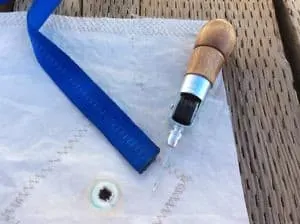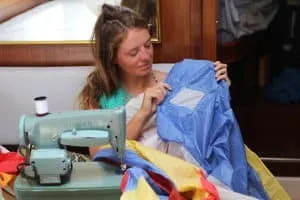
Keeping a well-stocked sail repair kit on board is important for preventing and minimizing sail damage. We bought a beautiful new set of sails for MonArk only 7 months ago and I have already put my sail repair kit to use on several occasions. With the right tools on hand you’ll be able to catch any damage and remedy it before it becomes a full blow repair job. Below I’ve listed what I carry in a basic coastal cruising kit and then a separate list with additional items that we carry offshore. I initially had some difficulty finding some of these products so I’ve included links to where you can buy them.
Why you should make your own sail repair kit
Many chandleries carry basic sail repair kits, and while this is a good place to start you’ll most likely want to supplement with items that will be particular to your boat’s sails (e.g. spare sail cloth that matches the weight, colour, and age of your current sails). Also, when you build it yourself you’ll have a better idea of everything that’s in there, it’s function, and ideally how to use it.
A quick note that this post contains affiliate links (so if you purchase through an Amazon link we’ll earn a small commission). All of the opinions are my own.

Basic sail repair kit
1 Seam Ripper Should you need to unpick any of your sewing.
1 pair of heavy duty scissors These should be kept in an oiled cloth and plastic bag to prevent rust.
Sewing Awl A sewing awl is a hand sewing tool that allows you to punch through thick fabric and manually produce lock stitches just like a sewing machine. Instructions for using an awl can be found here.
Hand-sewing palm A palm allows you to use your hand to drive a needle through thick or multiple layers of fabric. The dull end of the needle goes in the thimble and you use the palm of your hand to drive the needle through thick assemblies of canvas or sailcloth.
8-yard roll of 10″ insignia Insignia is Dacron cloth with a sticky back. The adhesive back allows you to quickly cut and place patches underway and prevent further damage. If you like you can later sew around the perimeter for additional strength though I’ve found it’s not necessary in most cases.
15 feet of 2″ 3 oz. Dacron tape An adhesive-backed Dacron tape for emergency repairs. Patches should be sewn later for a more permanent repair.
Spinnaker repair tape Adhesive-backed tape for repairing your Spinnaker. Adhesive holds well without sewing but can sew around perimeter if desired.
1 role 1/2″ seamstick A double sided tape that bonds to Dacron, nylon vinyl, and cotton. It’s helpful for holding patches and hems in place before sewing because thick fabrics are difficult/impossible to pin in place.
2 small tubes 5200 fast cure When Dan Neri tested the adhesive strength of 5200 on Dacron he found it has a breaking strength of 160 pounds per square inch – that’s strong! This makes it a great adhesive to keep handy especially for patching sails.
Additional repair kit items for offshore
Spare razor blades stored in oiled cloth and plastic bag
30 pushpins
Portable drill and small diameter bits
Hot knife For cutting and sealing rope, webbing, and synthetic fabrics that would otherwise unravel.
Large cuts of matched sail cloth and canvas for each sail. If you go to your local sail maker you can likely pick out some cloth from their scrap pile. Try to find a piece that matches the age/wear of your sail as closely as possible.
Care and maintenance of your kit
As with any valuable toolkit on a boat you need to be diligent about keeping and protected. Keep your gear dry in a water tight bag or container and periodically oil any metal items (like scissors or awls). Adhesives do go bad over time you’ll want to replace them every two years.
Good luck with putting your sail repair kit together and happy sailing!
Fiona McGlynn is an award-winning boating writer who created Waterborne as a place to learn about living aboard and traveling the world by sailboat. She has written for boating magazines including BoatUS, SAIL, Cruising World, and Good Old Boat. She’s also a contributing editor at Good Old Boat and BoatUS Magazine. In 2017, Fiona and her husband completed a 3-year, 13,000-mile voyage from Vancouver to Mexico to Australia on their 35-foot sailboat.


John howard
Sunday 16th of April 2017
The cordless drill or a hand operated drill is priceless when you are attempting to sew thick assemblies by hand. You can punch the holes first and then pass the needle through with minimum effort. Really great for emergency repairs on a tossing boat and we all know that is when stuff breaks.
Robin
Wednesday 31st of May 2017
Very true and good tips. Maybe an article on tools to have onboard for long passages is in order